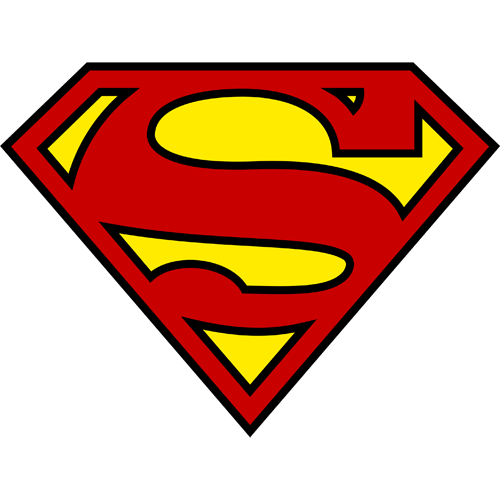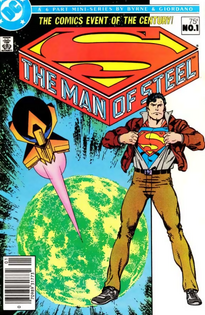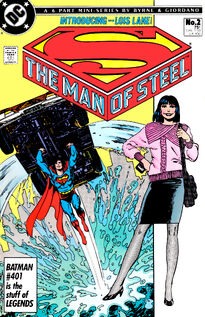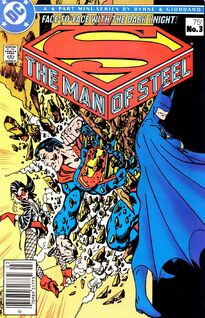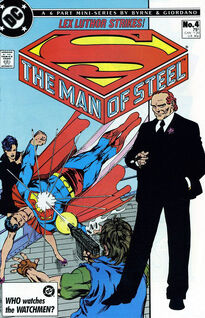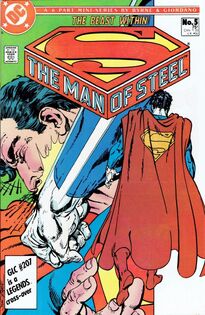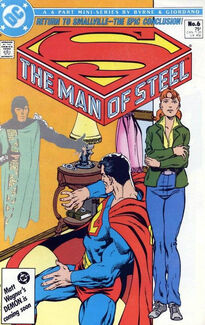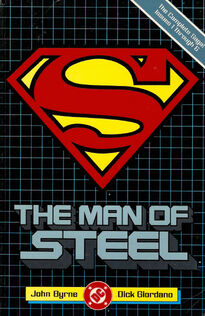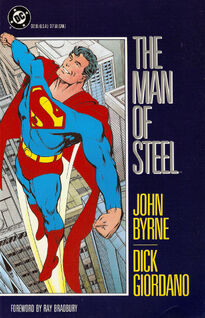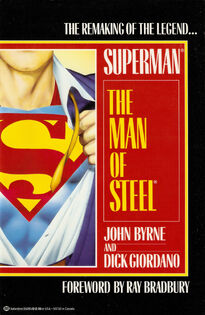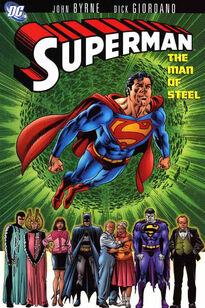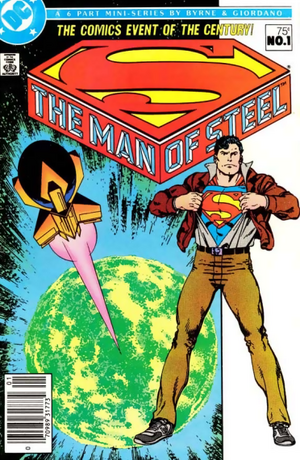
The Man of Steel was a six-issue limited series released in 1986 by DC Comics, several months after the twelve-issue limited series Crisis on Infinite Earths completed. The Man of Steel was written and penciled by John Byrne and inked by Dick Giordano. This story is sometimes retitled Superman: The Man of Steel in trade paperbacks.
Overview[]
The mini-series was designed to reboot the Superman mythos. Using the history-altering effects of Crisis as an explanation, it was decided by DC to give Superman an updated look and feel by completely rewriting his history, as an attempt to attract more readers. Thus, for modern comics, Man of Steel is the dividing point between the previous canon and the current one; most comic fans refer to the two different versions as "pre-Crisis" and "post-Crisis", per Crisis on Infinite Earths being the major dividing line across DC's universe as a whole. The pre-Crisis stories were drawn to a close in Alan Moore's "Whatever Happened to the Man of Tomorrow?".
From 2004 until 2007, this and Superman: Birthright were regarded as the "official" origins of Superman. However, after the DC's universe spanning event Infinite Crisis, both this series' and the Birthright portrayals of Krypton and Superman's birth have been removed as the "official origin" in favor of a new origin story that has yet to be told. A portion of the new origin appeared in Action Comics #850, which showed Kal-El being born moments before going into his ship and being sent to Earth.
The Man of Steel was followed by three four-issue mini-series which retold the world of Superman, called The World of Krypton (December 1987 - March 1988), The World of Smallville (April - July 1988), and The World of Metropolis (August - November 1988), all of them written by Byrne.
Story[]
The Man of Steel retells Superman’s story beginning with his origin. Each issue focuses on a different time in the early years of his career. In telling the story, Byrne drew from all available media to have depicted Superman for inspiration.
The series reboots Superman continuity for a modern audience. Previous depictions of the comic book Superman and his mythology are discarded. Some characters’ backgrounds were largely altered.
#1 From Out the Green Dawn[]
The first issue chronicles the origin of Superman, from his flight from Krypton to his arrival on Earth where he is discovered by his adoptive parents, the Kents. The story fast forwards to a high school football game after which adoptive father Jonathan Kent takes the now-teenaged Clark for a ride. By this time, Clark has developed most of, if not all, his powers as Superman. Jonathan reveals to Clark the truth that he (Clark) was never their biological son and that he was found from a crashed spaceship. The revelation causes Clark to decide to use his powers for the greater good. For the next few years during his studies in university, he has been saving lives and averting disasters in secret until an experimental space shuttle forces him to expose himself to the public. He meets Lois Lane for the first time and both felt a connection to each other but before they could react to it, a mob surrounds them. Clark is unable to deal with the sudden attention. In order to preserve Clark’s secret identity, Jonathan comes up with the idea of a superhero identity. Clark adopts a costume and the name he was given in the news, Superman.
- The planet Krypton was a cold and emotionally sterile planet, an idea Byrne borrowed from Superman: The Movie.
- Kal-El was not an infant sent from Krypton to Earth; rather, his Fetus was placed in a "birthing matrix" equipped with a rocket engine and Jor-El's experimental warp drive, with Kal-El gestating during the trip to Earth; once the rocket landed, Kal-El was fully "born" on Earth. This also made him "born" an American, a plot point that would be used in Armageddon 2001, a DC Comics storyline which explored possible futures, one of which featured Superman becoming President of the United States.
- Clark's abilities developed gradually in the yellow sun environment, starting with resistance to injury, then strength, x-ray vision, etc., with his ability to fly being the last to emerge. It took until his late teen years for all of his powers to develop; thus, Clark only adopted the Superman identity in adulthood, and never was Superboy.
- The Kents secretly adopted Clark and passed him off as their biological son. Prior to finding Clark, Martha Kent had a history of failed pregnancies. Friends and relatives assumed that they kept Martha’s “pregnancy” a secret in fear of losing another child. A blizzard that closed off Smallville also helped in the Kents’ alibi. In some pre-Crisis depictions, the Kents surrendered baby Kal-El to an orphanage before having a change of heart and legally adopting him as their own. The Man of Steel, Birthright, and Smallville all involve the same circumstances and cover-up of Clark's adoption. Although in Smallville the problems raised and the cover up of his adoption were taken in a much more serious and realistic manner.
- Clark mentions that he has been making Metropolis his base of operations for about three years.
- While the pre-Crisis Superman's costume was invulnerable (as a result of being made from the blankets in the rocket that brought him to Earth), the post-Crisis Superman's costume was made of ordinary material. But while the cape often became ripped and torn (or even completely destroyed on occasion) for dramatic effect, the rest of the costume was usually left untouched. It was later explained that the post-Crisis Superman's body generated an invisible "aura" that surrounded him and contributed to his invulnerability. Objects held close to him, such as his costume, were protected from harm; his cape, meanwhile, could easily sustain damage in battle. The Superman S-shield is an original design by Clark and Jonathan.
- Byrne made some adjustments to Superman's costume. While keeping every classic element, he significantly increased the size of the S-shield so that it almost entirely covered the chest. The cape is also made larger and longer, its flowing in the air made to look more dramatic.
- At the end of the issue, Clark/Superman is about 24/25, as shown below, the rest of the story takes over four years, which ends with him at 28/29, depending on which month it ends. The advancement in pacing is because although a reboot of continuity, Superman comic books still had to keep continuity with other books that DC published, for example Batman or Justice League, thus the origin story is spread out so the regular book would not conlfict with other publications in continuity terms.
#2 The Story of the Century![]
Daily Planet editor-in-chief Perry White assigns Lois Lane to get an interview with Superman. Meanwhile, Superman is all over Metropolis rescuing citizens and foiling bank robberies. After a series of failed attempts to interview Superman, Lois decides to take a gamble and plunges her car into the harbor. Superman arrives and takes her home. She finally has the scoop on Superman only to find out she was beaten to the headline by the new reporter, Clark Kent.
- Lois Lane was written as an aggressive reporter and person from the start, and never expressed a desire to find out Superman's secret identity (and indeed, never seemed to consider that Superman might have an alter-ego). She was also responsible for coming up with the name Superman, as she had in different formats of the character (such as Superman: The Movie and Superman: The Animated Series).
- Lane was also given a reddish-brown head of hair instead of black with blue being used as a Non local color to indicate details.
- The Mr. L in the limousine who wished to talk with Lois is none other than Lex Luthor.
#3 One Night in Gotham City[]
Superman and Batman meet each other for the first time. Batman is on the trail of the criminal known as Magpie. He is interrupted in a lead by Superman who regards him as an outlaw. Rather than risk capture, Batman informs Superman that should the latter make any attempts to come near him, a signal will be activated that will trigger a bomb and kill a person somewhere in the city. The two are forced to work together and eventually capture Magpie. In the end, Batman reveals to Superman that the endangered person is Batman himself. Superman departs cautioning Batman against crossing any further lines. Batman admits to himself of a respect for Superman’s innate goodness and wonders if, in a different reality, they could have been friends.
- Superman's relationship with Batman, which was friendly pre-Crisis became much more tentative, as each disagreed with the other's methods and attitudes. An allusion is made to their pre-Crisis friendship with Batman’s pondering at the end of the story.
- Batman mentions that he had read Superman's debut in the Daily Planet news reports eight months ago.
#4 Enemy Mine...[]
Lois and Clark are guests at a party to be held on Luthor’s luxury liner. Upon arriving, they are entertained by Luthor in his private chamber on the ship. When Luthor insinuates his desire of Lois, the latter is offended having some knowledge of Luthor’s past. Lois refuses to be one of Luthor’s trophy wives and decides to leave the ship. She and Clark are then confronted by South American terrorists who promptly throw Clark overboard. As the terrorists are trying to cordon the hostages, Clark changes to Superman and lifts the liner ship which surprises everyone on board. This opens an opportunity for Lois to seize control and knock out the terrorists. Luthor then reveals that he allowed the terrorists to get on board just so that he could coax Superman to come and include him on his payroll. Superman refuses Luthor’s offer and is deputized by the mayor of Metropolis to arrest Luthor. A few days later, Luthor confronts Superman and warns him of a day of reckoning.
- Superman's arch-nemesis Lex Luthor was no longer a Mad scientist but instead a power-hungry Billionaire, "the most powerful man in Metropolis," who resented Superman's overshadowing presence. Instead of battling Superman directly, Lex would use hired minions and staff on his payroll or manipulate others to confront Superman, while employing various methods (bribery, plausible deniability, legal trickery, etc.) to ensure that none of the incidents could be conclusively linked to him.
- Clark mentions that it has been almost eighteen months since he beat Lois on the scoop on Superman.
#5 The Mirror, Crack'd[]
The story begins with Superman confronting Luthor after foiling another of the latter’s revenge schemes. However, Luthor is able to elude arrest when Superman is unable to tie the villain to his criminal act. Superman leaves but not before his body is scanned by Dr. Teng’s cloning machine. Due to Superman’s alien heritage, the machine is unable to duplicate his DNA as it can only recognize known lifeforms. At first the clone appears to be a perfect duplicate of Superman until it keels over unconscious and its body starts to crystallize. Frustrated, Luthor orders the body to be disposed of. Days later, the duplicate resurfaces thinking it is Superman and helping Metropolitans. The people, upon seeing it, flee in fear. It later meets a blind Lucy Lane, Lois’s sister, who attempted to commit suicide by jumping off a building. Superman encounters the creature and engages it in battle. The fight ends in a final blow, shattering the imperfect duplicate into a dust cloud which somehow restores Lucy’s sight.
- On the opening page of this issue, Superman is seemingly capturing Luthor, who is wearing his pre-Crisis power suit. However, the next page reveals that it is one of Luthor's pawns in the suit. Luthor claims that the suit had been stolen and that he had no knowledge of the plot to attack Superman. Unfortunately, the suit's systems have left the man inside a vegetable, unable to tell the truth of Luthor's involvement. The reader later learns that Luthor was responsible for all of the above, which Superman suspects.
- The villain Bizarro was established as an imperfect clone of Superman, created from the superhero's DNA, rather than as a duplicate resulting from an imperfect duplicating ray. Furthermore, Bizarro is no longer an "imperfect opposite" of Superman and as such, has identical rather than opposite powers. Though the duplicate is referred to as "bizarre" in-story, it is never explicitly named "Bizarro"; that name will not be established post-Crisis until years later, when another imperfect duplicate created by the same process runs rampant in Metropolis.
- Lois mentions that she has been dreaming of kissing Superman for five years now, indicating that he has been active in Metropolis at least that long at this point.
- The restoration of Lucy's sight is an element borrowed from Bizarro's original debut in Superboy #68, right down to the dust cloud; it is intimated that the duplicate deliberately sacrifices itself after hearing that Lucy's sight began to improve after contact with the creature.
#6 The Haunting[]
Clark returns to Smallville after a long time away. His adoptive parents pick him up. Jonathan Kent was about to tell him something but Martha shushed him. Later that night, Clark could not sleep as he wonders what his Pa Kent was about to tell him. When he went for a midnight snack, a “ghost” of Jor-El surprises him and touches him. Superman discovers himself to be on an alien planet where he encounters his biological mother, Lara. As the hallucination wears off, he is face to face with his old flame, Lana Lang. In a flashback, it turns out that on the night that Clark learned his heritage he went to Lana and revealed the truth of his powers to her. She confesses her feelings to him. She realizes that Clark can no longer belong to her, that he belongs to the world and this fact had hurt her. She had gone through a period of depression and finally accepts the fact. The next day, Superman thinks about what she said and starts wondering about where he truly came from. He goes to the location where Jonathan hid the rocket ship he was found in only to find that the ship is gone. The hologram of Jor-El reappears and tells him to be silent and to learn. It appears that Superman is under some kind of psionic attack but the Kents arrive in time and break it off. Superman flies away, realizing that it was not a mental attack but a download of knowledge of everything about Krypton into his brain. He finally knows his true parents and where he came from and though he appreciates the knowledge he has been given, in the end, he embraces his humanity ever more.
- Superman was made the sole survivor of Krypton's destruction (vs. the earlier version having other survivors such as Supergirl, Krypton, etc. attached to him).
- Superman had no memory of his existence on Krypton, but he instead identified himself as a citizen of Earth.
- Pre-Crisis, Pete Ross knew of Clark's abilities since they were teenagers, while Lana Lang suspected Clark of being Superboy. Post-Crisis, Pete never learned this information. Instead, Clark revealed his abilities to Lana just before he left Smallville.
- Clark's adoptive Earth parents, Jonathan Kent and Martha Kent are alive and well in Clark's adulthood, and Clark visits them periodically. Pre-Crisis, they had died shortly after Clark's High school graduation.
- Clark is twenty-eight years old by the time the story ends.
Issues[]
Collections[]
The series has since been collected in trade paperback form in several editions, sometimes retitled as Superman: The Man of Steel. The first used a better paper stock after the series’ completion. In 1993, it is reprinted with newsprint-type paper and priced cheaper. More recently in 2003, it sported a new cover by Jerry Ordway as Superman: The Man of Steel vol. 1, the first in a series of trade paperbacks collecting the early adventures of the post-Crisis Superman.
Background Information and Notes[]
Unused ideas[]
In some pre-Crisis retellings, Jor-El wanted to save both Lara and Kal-El by sending them away in the same rocket, but she would refuse saying that the rocket was too small and might not make it to Earth because of her addedweight, and she wanted to stay with her husband (This was an idea that was briefly touched on in Superman: The Animated Series). Byrne's proposed idea was to show a pregnant Lara leaving Krypton. After landing near Smallville, Lara would immediately succumb to a small chunk of kryptonite that was embedded in the ship's hull. This would have been Byrne's way to show early on how deadly kryptonite was. Lara would then have been found by the Kents while she was in labor, induced by the stress from kryptonite poisoning. Before dying, Lara would have told the Kents to look after her son. They would then take young Kal-El, an alien born on Earth, and raise him as their own just as they promised his mother. This was also Byrne's way to emphasize the Kents being chosen caretakers rather than them being a random couple who finds a baby in a rocket. The idea was not used because DC wanted Kal-El to be sent to Earth alone, as all the previous incarnations agreed upon.
Originally, the Legion of Super-Heroes were inspired by and formed based on legends of Superman's adventures as a boy. As a result of Byrne's new continuity, the Legion eventually had their backstory changed such that these adventures never happened.
Another unused idea was to show Lois Lane and Lex Luthor being romantically involved and living together in Luthor's estate in the mountains until Superman came to Metropolis. Lois would then leave Luthor to go after Superman, another reason for Luthor to hate Superman. This idea was scrapped because Byrne did not want Lois as someone who was drawn to power (and he didn't want any mountains shown alongside the city). However, Man of Steel depicts Lois and Luthor as having only casually dated.
Impact of changes[]
The Man of Steel became the official origin story for Superman from 1986 through the early 2000s. Its changes to the origin story were adapted to other media featuring Superman. Many of the biggest changes were on Superman himself. While many of his standard superpowers remained, Superman was effectively limited in power and scope to make him more believable. He still had superhuman strength, vision powers and super breath but while the Silver Age Kal-El at his peak could easily move planets, the post-Crisis version strained at moving a commercial Airliner in flight. His vision powers still include x-ray, heat and microscopic/telescopic vision but are set at a more realistic level. He no longer had the ability to survive in space indefinitely without an air supply as he had done often in pre-Crisis stories. The powers dropped in succeeding stories include his ability to travel through time, freeze breath (though he still possessed super-powerful blowing strength), and super intelligence.
Byrne made the most important changes to Superman's personality. Superman's alter-ego Clark was no longer "mild-mannered"; he became more assertive, and an important half of a double life. Man of Steel established Clark Kent as the "real" person, with Superman being the "disguise" - a reversal of the earlier canon. Stories featuring people actively trying to discover Superman's secret identity became practically non-existent. It was not known to the general public that Superman had a secret identity since he did not wear a mask, and most generally assumed that Superman was the full-time identity. Additionally, Superman's status as the sole survivor of Krypton is restored. This resulted in the writers having to come up with an alternative explanation to related characters such as Supergirl and General Zod and the Phantom Zone villains.
The changes among Superman’s cast include Lana Lang, Jimmy Olsen and Lex Luthor. Lana and Jimmy did not adopt any superhero identities (pre-Crisis they frequently developed superpowers). Lex Luthor became an evil billionaire (inspired in part by his portrayal by Gene Hackman). Clark's adoptive parents are still alive and well and remain important supporting characters to this day.
After the limited series, Byrne took over the storytelling in the monthly Superman series. The change he made to Superman’s greatest weakness, Krypton, was limiting the form to only the original green varity. Other variant forms of Kryptonite such as gold, yellow, blue and white no longer existed; only green remained. The other red version of Kryptonite would eventually resurface later on. Kryptonite was also made a much rarer element and extremely hard to find and acquire, in fact early on only Lex Luthor had access to it, this knowledge allowed Superman to know who supplied Bloodsport with Kryptonite bullets. Because of this it eliminated a previous plot element of even the most common criminals using the radioactive object to elude or eliminate Superman. Superman's enemies had to become even more creative in finding a way to battle him.
The removal of Clark's Superboy career, as well as Supergirl, from continuity would have a serious impact on The Legion of Super-Heroes. Byrne would later state that removing Superboy from continuity was a mistake.
Adaptations[]
In 1990, the series was adapted into a radio play simply entitled The Adventures of Superman by Dirk Maggs for BBC Radio 4. It featured Stuart Milligan as Clark Kent / Superman, William Hootkins as Lex Luthor, Lorelei King as Lois Lane, Vincent Marzello as Jimmy Olsen, Garrick Hagon as Perry White, Shelley Thompson as Lana Lang, Dick Vosburgh as Jor-El, Barbara Barnes as Lucy Lane, David Graham (actor) as Fisher, Simon Treves as Metallo, Elizabeth Mansfield as Amanda McCoy, Burt Kwouk as Doctor Teng, and Jon Pertwee as Schwarz.
Legacy[]
Birthright[]
In 2004, another story of Superman's origin, a 12-issue limited series called Superman: Birthright, was published, which DC stated that this, and Man of Steel, was the full "official" origin for Superman. Birthright made use of many elements of Man of Steel that tied into the other series, but also introduced new aspects ignored by Byrne or brought back various pre-Crisis elements (such as Lex and Clark as childhood friends in Smallville). The Kara Zor-El version of Supergirl was also brought back, while the recently-shocking DC Comics storyline Infinite Crisis made further changes to Superman. Both Man of Steel and Birthright were in canon as the official origins of Superman.
Post-Infinite Crisis[]
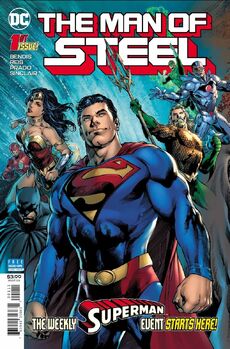
1986 logo used on a 2018 mini-series, also a reimagining by a "superstar" writer.
In April 2007, the then-monthly Superman writer Kurt Busiek stated that the origin of Superman in post-Infinite Crisis continuity has yet to be established. Due to the conflicting portrayals of Jor-El, Krypton, and Lex Luthor's background, both of these series have been removed from canon.
The current Post-Infinite Crisis canon contains some aspects of Man of Steel, some from Birthright, but it has a great deal coming from the Richard Donner/Bryan Singer film continuity. Much like the film's depiction Krypton is depicted as a crystalline world possessing much greater technology than Earth. Also, like the film and Birthright, the "S" symbol represents Hope and is the House of El crest. In lieu of Kal-El being sent to earth as a fetus, he was born before Krypton was destroyed. The long-time Silver Age nemesis of Jor-El, General Zod, is also introduced in post-One Year Later. Like the Donner film, he, Ursa, and Non were formerly respected leaders of Krypton, but they were put in the Phantom Zone for leading an insurrection on the planet.
Lex Luthor's origins are also explained in full. He did, like Birthright depicts, meet Clark Kent in Smallville and interacted with him, and later left under a cloud of suspicion. Unlike what was shown in the Waid version, Clark did not become his only friend (he's also shown befriending Pete Ross and Lana Lang), he was not involved in Lex's baldness, nor was there any accident that disfigured Luthor that cost him his hair. In the OYL Superman: Up, Up and Away! and Last Son arcs, he recalls having created Bizarro to destroy Superman but failed.
DC later used this series as a template for writer Brian Michael Bendis to rethink Superman continuity, again titled simply The Man of Steel, even using one of the 1986 logos from Byrne's series.
